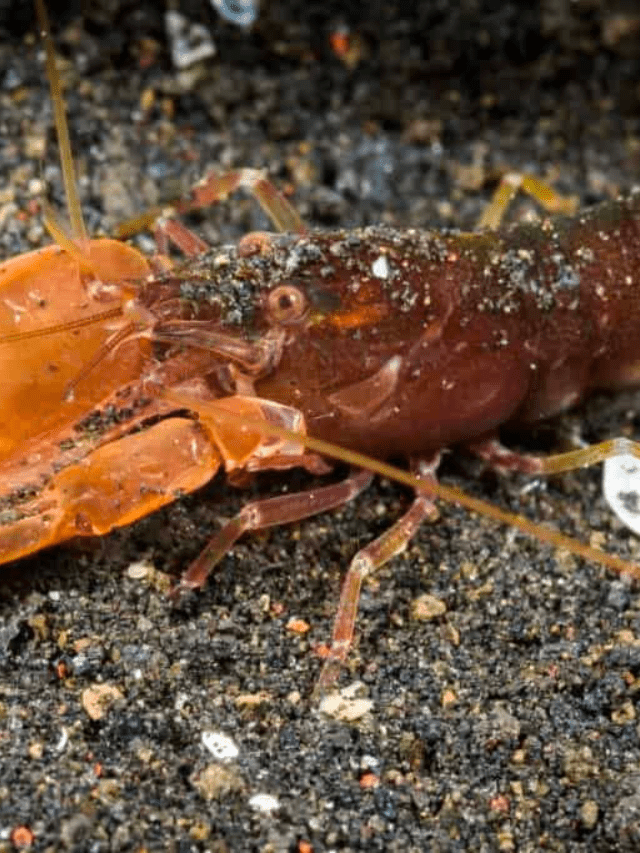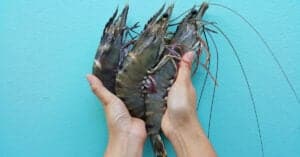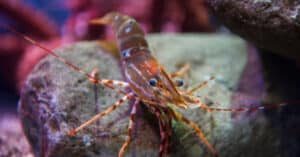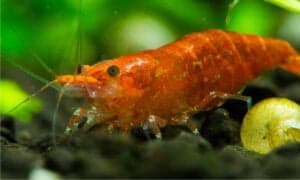Bang. Bang. Bang.
The pistol shrimp cocks its distinctive claw back and “fires” repeatedly at nearby prey. Each time its claws snap, bubbles shoot forward and for a brief moment produce nearly as much heat as the sun’s surface!
The sound from each claw snap is incredible, hitting 218 decibels, a noise loud enough to knock nearby animals unconscious.
The pistol shrimp is one of the most uniquely evolved predators across the natural world. Yet, even with its distinctive snapping claw, it must often rely on trusted companions for survival.
To learn more about this animal and see just how loud 218 decibels is, read on below!
5 Incredible Pistol Shrimp Facts!
- Almost as hot as the sun’s surface: The pistol shrimp’s claws “shoot” small bubbles that produce incredible amounts of energy. In fact, they can reportedly reach temperatures of nearly 4,800 degrees Celsius! That’s only slightly less than the sun’s surface temperature of 5,600 Celsius. However, while this temperature spike is extreme, it’s also confined to a very small area.
- Pistol shrimp can regenerate their claws: The loud snapping noise pistol shrimp produce is their primary means of hunting prey, but what happens if they lose a claw? Amazingly, when pistol shrimp lose their snapping claw, their smaller claw will grow in size to replace it. The lost claw will then regenerate into a smaller claw, effectively “switching” which side their oversized snapping claw is on!
- Nature’s jackhammer: Some pistol shrimp species use the force produced by their claw’s snap to chisel into rock faces and create dwellings.
- A “natural celebrity”: The pistol shrimp was recently featured in Netflix’s Project Power. The film’s main character — played by Jamie Foxx — inherits the powers of a pistol shrimp. Netflix reports the movie has been streamed more than 75 million times, and its success has attracted growing interest in pistol shrimps.
- 218 decibels: The bubbles pistol shrimp produce can reach up to 218 decibels. Just how loud is that? Decibels rise exponentially. That means a 120-decibel rock concert is a million times louder than a 60-decibel conversation. The 218 decibels a pistol shrimp produce are even louder than a fighter jet taking off! The graphic below demonstrates how truly off-the-scale the sound of the pistol shrimp’s snapping is!
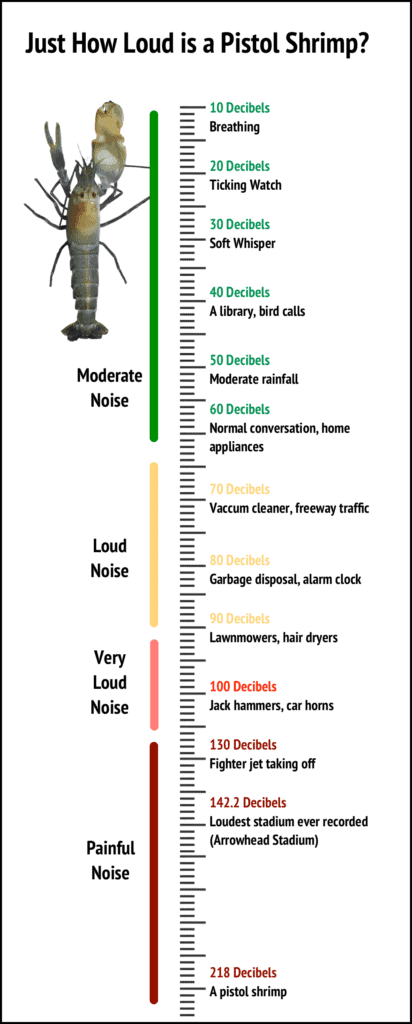
Pistol Shrimp Appearance
The pistol shrimp (also known as the snapping shrimp) is a family of shrimp species that is found mostly in tropical waters and has a distinctive over-sized claw.
The more than 500 species of pistol shrimp all differ slightly in appearance and location but share the large boxing-glove claw with the other one being slightly smaller in size.
These tiny creatures aren’t harmful to humans, nor can we be affected by their claw. However, pistol shrimp have the ability to create incredible heat and sound that would damage their predator’s. These small yet powerful shrimp are about two inches long and can be heard over a quiet boat if you listen closely.
Although it may seem that pistol shrimps have evolved these to have a stronger claw for both hunting and fighting, it is actually designed for these things but works in a very special way. By snapping the claw shut, pistol shrimps are able to stun their prey before they are then safe to kill and consume it.
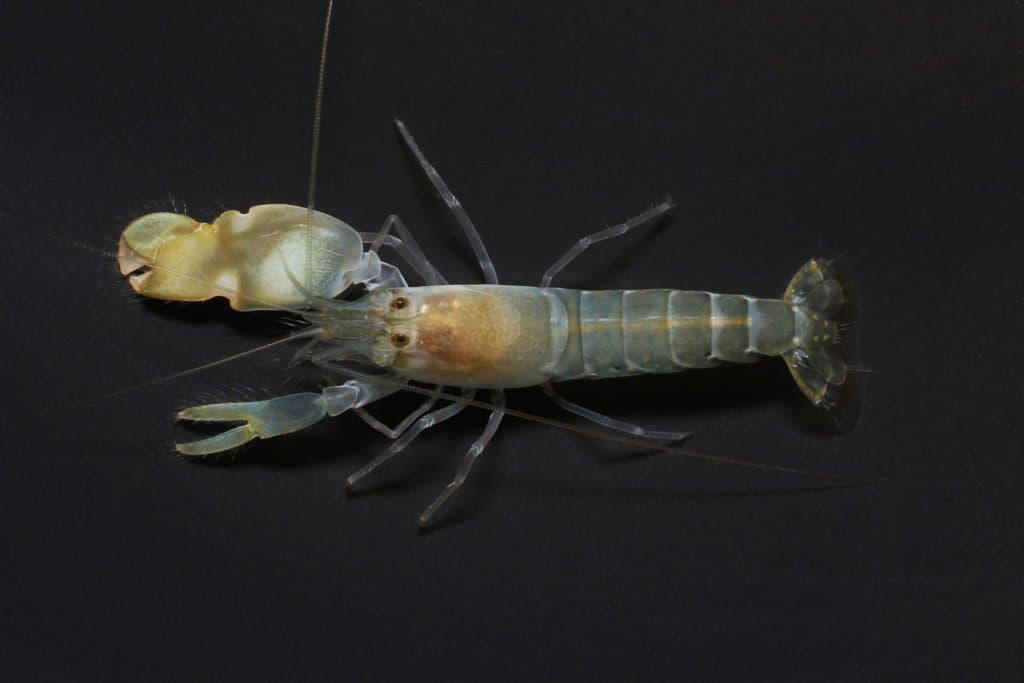
By snapping their stronger claw shut, pistol shrimps are able to stun their prey before they consume it.
©Matthew R McClure/Shutterstock.com
How Pistol Shrimp Claws Work
Pistol shrimp claws snap together with such force that they produce a stream of water that travels as a pressure bubble at speeds of roughly 71 mph (105 feet per second) towards its prey. Once popped though, the deafening crack of these bubbles reaches up to 218 decibels. It also:
- Emits light for a billionth of a second.
- For a fraction of a second, temperatures in the bubble soar to nearly 4,800 degrees Celsius (which is a remarkable outcome from a two-centimeter long animal shutting its claw!)
- And also stuns small fish and crabs instantly.
Now, the first question you’re probably asking yourself is “how can a tiny creature produce temperatures nearly as hot as the sun’s surface and noise louder than a pistol firing?”
The answer comes from the unique structure of the pistol shrimp’s snapping claw.
When pistol shrimp open their claw, water fills into a “socket.” The other half of the claw is a plunger that rapidly closes and ejects water that escapes through small grooves at extremely high velocity.
What happens next is a phenomenon known as a cavitation bubble. Pressure drops dramatically which vaporizes local water. Tiny bubbles grow large as pressure plummets, and as pressure rises back to normal they suddenly break with tremendous energy.
Think of it almost like water being ripped apart!
In the instant this bubble pops, a flash of light appears for as little as 10 nanoseconds, temperatures reach as high as 4,800 degrees Celsius, and an incredible noise is generated. The shockwave generated from cavitation stuns (or even kills) prey in its path.
Pistol shrimp will repeated point their claw at their prey (pistol shrimp eat crabs, other shrimp, small fish, and other opportunistic meals), cock their claw back and fire over and over again.
After knocking its prey unconscious, the pistol shrimp will drag it back to its lair using its smaller pincer claw.
218 Decibles: Just How Loud is a Pistol Shrimp?
Pistol shrimps also use their large claws for fighting with rivals competing to see which can make the loudest bang. Their claws have reached a sound frequency of around 218 decibels (colonies of pistol shrimp are said to sound like heavily sizzling fat to divers).
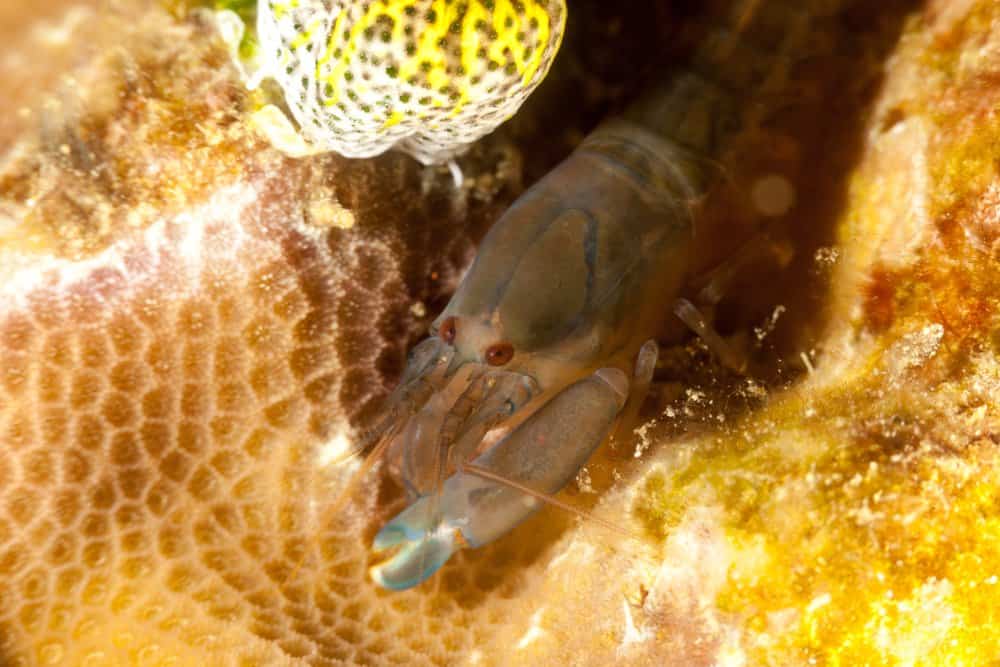
Pistol shrimps use their large claws for fighting with rivals and have reached a sound frequency of around 218 decibels.
©Gerald Robert Fischer/Shutterstock.com
Just how loud is this?
- A soft whisper comes in at about 30 decibels.
- Normal conversation registers at 60 decibels.
- Noisy lawnmowers and hair dryers produce about 90 decibels of noise.
- Most concerts (don’t forget to pack your earplugs!) don’t exceed 110 decibels.
- The loudest stadium ever recorded was during a Kansas City Chiefs game at Arrowhead Stadium, it registered 142.2 decibels.
- And fighter jets taking off, fireworks, gunfire, and emergency sirens rarely produce 150 decibels.
- Yet, the sound of pistol shrimp bubbles popping generates 218 decibels!
You can see a comparison on the chart below. And if you’re wondering if any animals can top the pistol shrimp’s 218 decibels, sperm whale clicks have been measured all the way up to 230 decibels!
Tiger Pistol Shrimp and Goby
With a claw that shoots bubbles that knock prey unconscious, you might expect the pistol shrimp to be a lonesome gunslinger on the bottom of the ocean, but it often relies on mutually beneficial relationships with other species to survive.
The most famous example may be the tiger pistol shrimp. This shrimp lives in shallow waters of the Western Pacific Ocean.
The main limitation of pistol shrimp is poor eyesight, which puts them at risk when they can’t spot threats. To counteract this weakness, tiger pistol shrimp will live in a burrow with a goby. The goby is able to spot threats in the burrow and can also share meals the tiger pistol shrimp brings back to the burrow. When nutrition sources are lean, the tiger shrimp can even rely on the feces of a goby fish to survive!
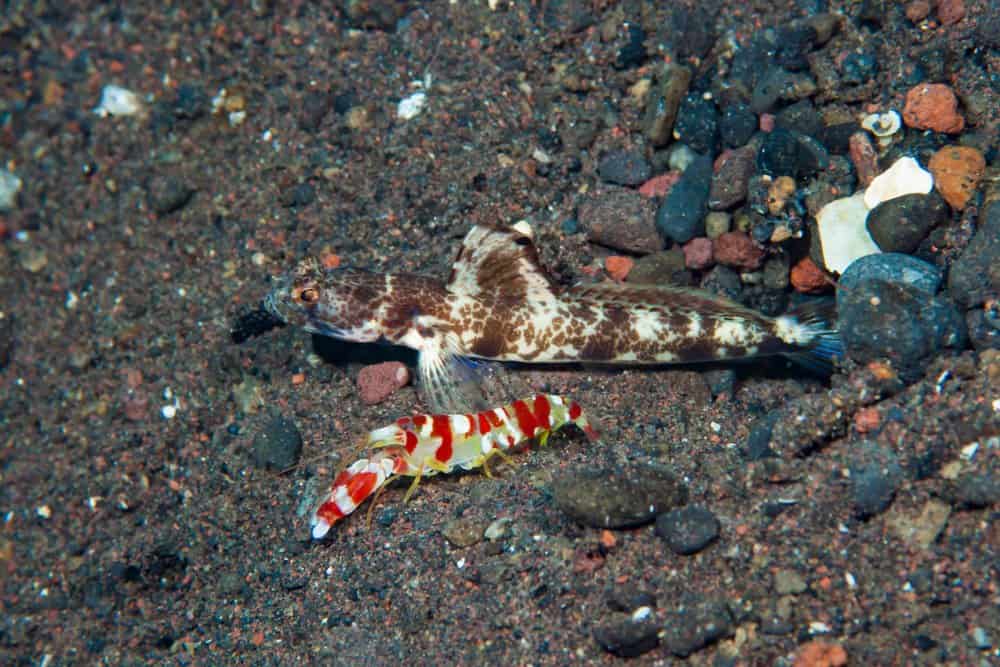
The tiger pistol shrimp and the goby maintain a symbiotic relationship, with the tiger pistol shrimp hunting for meals and the goby spotting potential threats.
©Francesco_Ricciardi/Shutterstock.com
Other pistol shrimp will live symbiotically with animals such as sea anemones. With more than 500 described species, there is a tremendous amount of biological diversity among different types of pistol shrimp!
Pistol Shrimp in Popular Culture
In August 2020, Netflix released a new superhero filmed named Project Power. The premise of the film was that “Power” pills had been developed that can give humans superpowers derived from animals. The main character in the film is played by Jamie Foxx and has abilities taken from pistol shrimp.
According to Netflix, Project Power has been streamed more than 75 million times, making it one of the most popular films on the streaming service.
Can a Pistol Shrimp Hurt a Human?
The short answer here is no. Pistol shrimp can’t hurt a human. There are no pinchers at the end of the crustacean’s claw. The only thing that a pistol shrimp can do to a person is annoying them with the sound they make. Although, pistol shrimp produce a immense heat and sound wave that can destroy their prey. People aren’t on that list.
Pistol shrimps interfere with their surrounding water, making them one of the loudest creatures on earth. In fact, during World War 2, their flows were known to damage many submarine propellers. Additionally their sound ruined some underwater communication. As annoying as the sound is, it isn’t damaging to human ears.
Next Up…
- Shrimp Poop: Everything You’ve Ever Wanted to Know – Do shrimp poop? Read this to find out!
- 10 Incredible Shrimp Facts – Interested in learning some neat shrimp facts? Keep reading!
- Discover the 3ft Giant Shrimp and Jellyfish Hybrid From 500 Million Years Ago – Check out this incredible find of a shrimp and jellyfish hybrid that lived 500 million years ago!
The photo featured at the top of this post is © Subphoto.com/Shutterstock.com
Sources
- David Burnie, Dorling Kindersley (2011) Animal, The Definitive Visual Guide To The World's Wildlife
- Tom Jackson, Lorenz Books (2007) The World Encyclopedia Of Animals
- David Burnie, Kingfisher (2011) The Kingfisher Animal Encyclopedia
- Richard Mackay, University of California Press (2009) The Atlas Of Endangered Species
- David Burnie, Dorling Kindersley (2008) Illustrated Encyclopedia Of Animals
- Dorling Kindersley (2006) Dorling Kindersley Encyclopedia Of Animals
Thank you for reading! Have some feedback for us? Contact the AZ Animals editorial team.



